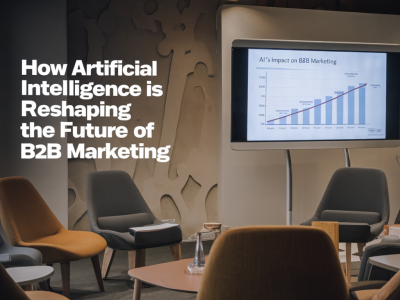
In today’s fast-paced B2B landscape, staying on top of emerging trends is not just an option—it’s a necessity. Every day, businesses like yours are faced with new challenges, disruptive technologies, and shifting market demands. I understand how overwhelming it can feel, but I believe there’s never been a more exciting time to navigate this space. That’s why I’ve crafted this roadmap to mastering the ever-evolving B2B world and ensuring your business remains competitive.
Understanding What Drives B2B Trends
To navigate B2B trends effectively, we need to start by understanding what fuels them. A significant driver is technological advancement, and trust me, if you’re not embracing it, you're falling behind. From AI-driven customer relationship management (CRM) tools like Salesforce to predictive analytics platforms such as Tableau, modern businesses are leveraging technology to enhance their internal operations and customer interactions. Staying current means being open to adopting these innovations.
Another major factor is changing buyer behavior. Gen Z and millennials are stepping into decision-making roles, and their expectations of seamless, tech-centric, and values-oriented experiences are shifting the B2B paradigm. The rise of platforms such as LinkedIn for networking and HubSpot for inbound marketing points to a preference for digital-first strategies that prioritize authenticity, speed, and personalization. Understanding your customer, their preferences, and how they wish to engage with you is key.
Focus on Creating a Customer-Centric Strategy
A customer-focused approach isn’t a new concept, but many businesses struggle to implement it effectively. Ask yourself: How well do you know your clients? Have you mapped out their buyer journey? Are you tailoring your offerings to meet their needs?
Success in B2B today means creating value at every touchpoint. Tools like customer data platforms (CDPs) can help consolidate data from various channels to create a unified customer profile. Imagine combining insights from email behavior, website visits, and social media interactions. Platforms like Segment and Tealium allow you to dig deeper into customer preferences, enabling you to create hyper-personalized campaigns. Leveraging this data is about more than just marketing—it’s about building long-term, meaningful relationships with your customers.
Adopting Agile Marketing Methods
If I’ve learned anything from working with businesses, it’s that flexibility is no longer optional. Agile marketing isn’t just for software developers; it’s becoming a staple in B2B strategy. But what does this mean for your business?
Instead of yearly marketing plans that are set in stone, agile marketing encourages iterative tactics, shorter planning cycles, and quick adjustments based on what’s working. For example, using A/B testing tools like Optimizely can help you refine your messaging and visuals in real time. Similarly, agile software like Wrike or Jira provides workflow visibility, ensuring every team member knows exactly what needs to be done and by when. By being adaptable, your marketing can align more effectively with dynamic market changes.
Understanding the Role of Sustainability in the B2B Space
Today, sustainability is more than just a buzzword—it’s a competitive edge. Companies that don’t take measurable action toward sustainability risk losing out to those that do. For instance, enterprise brands like Unilever and IBM have built entire B2B initiatives around sustainability goals, enhancing their reputation and driving customer loyalty in the process.
So, how can your business align itself? Start by assessing your supply chain and seeking partners that prioritize eco-friendly practices. Showcase certifications such as ISO 14001 or leverage tools like EcoVadis to communicate your efforts to clients. Remember, buyers are increasingly prioritizing partnerships with companies that operate ethically—this could be your chance to demonstrate leadership in your industry.
Explore the Impact of Artificial Intelligence
Artificial Intelligence is no longer a nice-to-have; it’s a game-changer. I’ve seen businesses revolutionize their operations through tools like ChatGPT (for customer engagement) or Zoho CRM (for smarter lead scoring). AI allows companies to analyze massive datasets, automate repetitive tasks, and predict customer behavior—all of which can significantly improve efficiency and accuracy.
Interestingly, the AI trend isn’t limited to tech companies. Industries as diverse as manufacturing, logistics, and education are utilizing AI to improve their B2B offerings. I’d recommend taking a close look at how competitors in your sector are deploying AI and brainstorming how you can follow suit. Although the initial investment may seem costly, the long-term ROI is absolutely worth it.
Investing in Upskilling Your Team
Let me be clear: no great strategy can succeed without the right people. While technology is advancing rapidly, it must still be paired with human expertise. One of the most valuable investments you can make is in upskilling your workforce.
Consider online platforms like Coursera or Udemy to ensure your team develops essential skills like data analysis, digital marketing, and AI integration. I’ve worked with businesses that have implemented regular training programs to stay ahead of industry trends, and the results are astounding. Not only do these companies improve their operational effectiveness, but they also report higher employee satisfaction and retention rates.
Embracing the Power of Networking and Partnerships
Business doesn’t happen in isolation—it’s built on relationships. Networking remains one of the most effective ways to stay relevant. Platforms like LinkedIn should be part of your daily routine, not just your yearly marketing review. Engage with thought leaders, comment on industry news, and share your expertise to build credibility in your sector.
Beyond individual networking, consider collaborative partnerships. Working with complementary brands can open you to new audiences and create unique, co-branded opportunities. One example I find inspiring is how HubSpot teamed up with Canva to offer content marketing tools to their user base—a win-win for both companies and their audiences.
Staying Ahead Through Strategic Experimentation
Finally, businesses that master B2B trends don’t just respond to market changes—they lead them. This requires a commitment to experimentation, whether it's testing new tools or exploring untapped marketing channels.
Think about the rise of immersive experiences like virtual reality (VR). While initially viewed as futuristic, companies like Red Bull and Cisco are integrating VR into their B2B strategies to drive engagement. Could experiments like these work for your business? It all starts with setting aside a portion of your budget for innovation and testing new ideas without fear of failure.
The path to mastering B2B trends requires a multi-faceted approach—embracing technology, focusing on customer needs, and adopting agile methods, all while keeping an eye on sustainability, AI, and team development. By committing to these strategies, you’ll be ready to stay not only relevant but thrive in an increasingly competitive marketplace.

